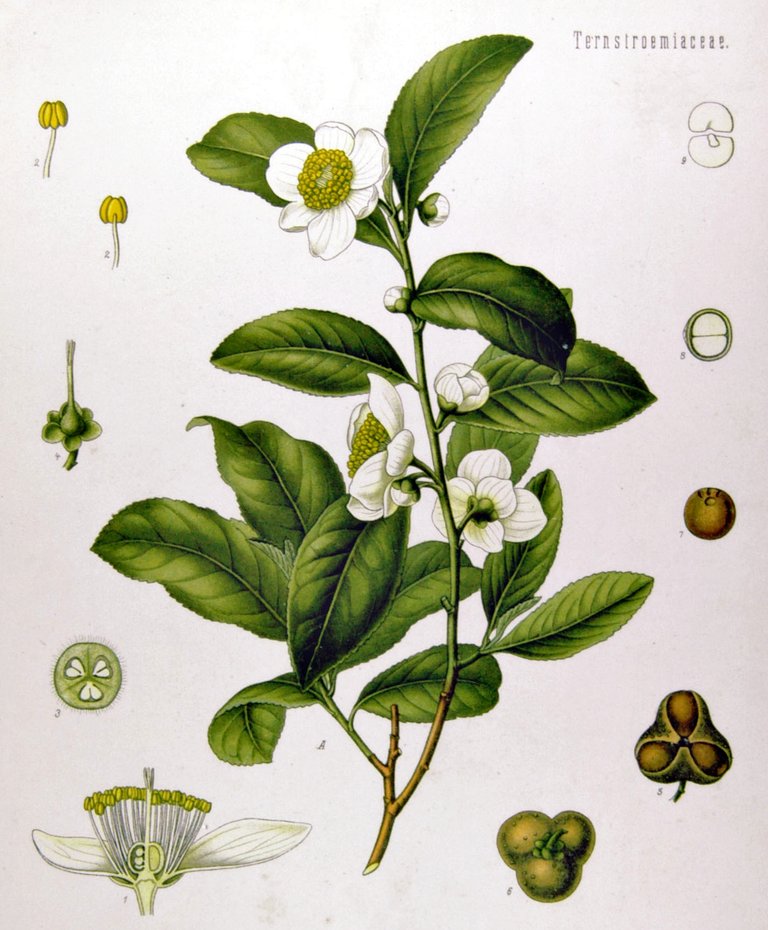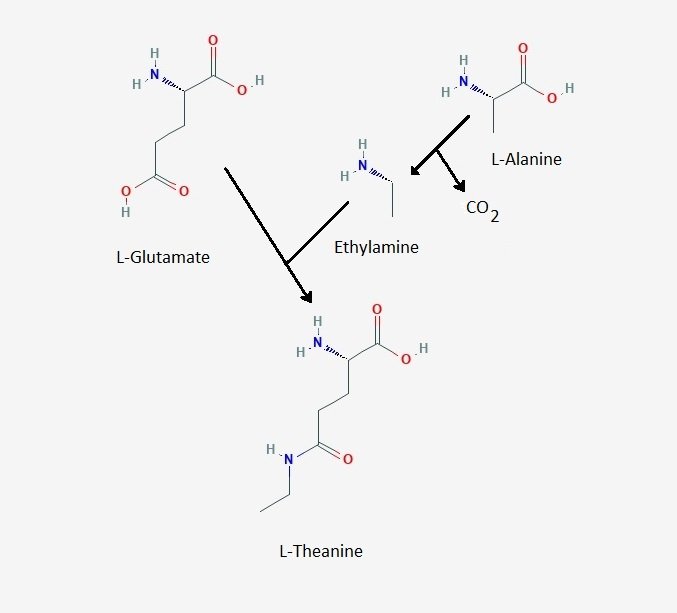
Tea plant (Camellia sinensis) from Köhler's Medicinal Plants, 1897
Tea is an ancient drink. It was grown 2100 years ago to cater for the drinking habits of the Western Han Dynasty, in western Tibet, China (Lu et al. (2016)).
Aside from the stimulant, caffeine, a major constituent of tea (Camellia sinensis) is the non-protein amino acid L-theanine. Theanine represents about 1% of the dry weight of green tea leaves although there are substantial differences between cultivars of Camellia sinensis in terms of theanine levels (Liu et al. (2017), Cheng et al. (2019)).
Theanine is an amide; a compound derived from L-glutamate and ethylamine. The precise origin of the ethylamine moiety of theanine has been the subject of debate, but this point has recently been clarified. Bai et al. (2019) recently discovered that ethylamine is synthesized by an alanine decarboxylase with similarity to previously identified serine decarboxylases. Earlier studies by Cheng et al. (2017) had indicated that ethylamine availability is a major reason for the difference in L-theanine accumulation between C. sinensis and other plants. Most plants contain the enzyme/gene catalyzing the conversion of ethylamine and L-glutamic acid to L-theanine. After supplementation with [2H5]ethylamine, all the plants produce [2H5]L-theanine (Cheng et al. (2017)). Thus, the presence/absence of alanine decarboxylase seems to determine ethylamine availability, and hence theanine accumulation. Deng et al. (2009) had previously shown, by radiotracer studies, that alanine is the precursor of the ethylamine moiety of theanine, and that the metabolism of alanine to ethylamine is higher in roots than other organs. Consistent with this, the newly identified alanine decarboxylase is expressed predominantly in young roots (Bai et al. (2019)).

Proposed pathway of synthesis of L-theanine
The enzyme that forms theanine from the substrates L-glutamate and ethylamine appears to be none other than glutamine synthetase (Mu et al. (2015)) which is ubiquitous in the plant kingdom. However, Camellia sinensis appears to have evolved a specialized form of glutamine synthetase (now designated L-theanine synthetase) (Wei et al. (2018)) with a higher affinity for ethylamine than ammonia.
Ashira (2015) summarizes the biosynthesis and metabolism of theanine in Camellia sinensis succinctly as follows:
Biosynthesis of theanine from glutamic acid and ethylamine by theanine synthetase is present in all organs of tea seedlings, but roots are the major site of theanine biosynthesis in adult tea trees. Theanine is transported from roots to young leaves via the xylem sap. Theanine is hydrolysed to glutamic acid and ethylamine in leaves. Ethylamine produced from theanine is predominantly used for catechin biosynthesis. From: Ashira (2015).
Differences in the rate of catabolism of theanine may be the primary cause of cultivar differences in theanine content (Cheng et al. (2019)).
Green tea has been used in traditional Chinese medicine for centuries (Saeed et al. (2017)). Theanine represents over 50% of total free amino acids in tea and has a significant contribution to the quality of green tea (Bai et al. (2019)). Theanine is one of the metabolites in tea that account for its rich taste and health benefits (Wei et al. (2018)). Much interest has been devoted to assessing the effects of L-theanine on mood, mental alertness and arousal (Nobre et al. (2008), Dietz and Dekker (2017)).
Williams et al. (2019) urge human trials to further investigate the anti-inflammatory and antioxidant properties of L-theanine.
"Several studies have reported that the consumption of this amino acid has many therapeutic effects, including improvements in brain and gastrointestinal function, cancer drug therapeutic efficacies, antihypertensive effects, and improved immune function" (Williams et al. (2019)).
While consumption of green tea is generally considered safe, there have been alarming reports of hepatotoxicity associated with green tea consumption (Mazzanti et al. (2015)). It is unclear at present whether these adverse effects are due to deliberate or unintentional contamination of the green tea with other plant tissues containing toxic alkaloids such as pyrrolizidine alkaloids (Schulz et al. (2015)).
References:
This post has been voted on by the SteemSTEM curation team and voting trail in collaboration with @utopian-io and @curie.
If you appreciate the work we are doing then consider voting all three projects for witness by selecting stem.witness, utopian-io and curie!
For additional information please join us on the SteemSTEM discord and to get to know the rest of the community!
Thank you!
Great read! Some of the best high-quality natural product content on Steem. Learning about the actives and the base of some of the common herbals and natural ingredients we all use is extremely helpful and interesting. We just gave you a small upvote together with our many followers of the @nunesso blog.
Have you heard of @nunesso? Using the #nunesso or #naturalproducts tag rewards authors and content creators who produce exceptional natural product related articles. Be sure to use our tag and get much bigger upvotes, resteems and be featured in our curation posts!
Learn more about our natural product project on Steemit by clicking on the banner above and join our community on Nunesso Discord
I'm a tea lover, too. I just read an interesting article about a genetically-deficient species of tea called HongYaCha. HYC cannot make caffeine because it has a mutation in caffeine synthase, according to https://steemit.com/steemstem/@diamondmind/a-compilation-of-information-on-alternative-medicine-how-anticancer-drugs-can-be-produced-in-yeast-a-new-tea-plant-with-low
Yes, that's true. Here's the original publication:
Jin, J-Q, et al. Hongyacha, a Naturally Caffeine-Free Tea Plant from Fujian, China. J. Agric. Food Chem. 66 (43), pp 11311–11319 (2018).
As noted in the paper, the plants still produce theobromine, which is the precursor of caffeine. Theobromine is the main alkaloid in Cacao. It is also a stimulant, but weaker than caffeine.
If I recall correctly, Theobromine is weaker, but lasts longer.
Loved this BTW, resteeming!
Thank you.
Hi @davidrhodes124!
Your post was upvoted by Utopian.io in cooperation with @steemstem - supporting knowledge, innovation and technological advancement on the Steem Blockchain.
Contribute to Open Source with utopian.io
Learn how to contribute on our website and join the new open source economy.
Want to chat? Join the Utopian Community on Discord https://discord.gg/h52nFrV
Thank you!
Great post and the newest possible references!
Thank you Professor
Thank you!
good luck~i
Congratulations @davidrhodes124! You received a personal award!
Click here to view your Board